Gasoline Prices Don’t Look As Bullish On The Charts With Only 3 Trading Days Left, Hurricane Franklin Reached Category 4 Status

Refined product prices came back to earth Monday after the tank fire at the Garyville LA refinery that sent prices soaring on Friday was finally extinguished with reports suggesting that no damage was done to operating units at the refinery.
The 10-cent drop puts ULSD at risk of snapping its record-setting 9 consecutive weeks of gains, even though the trend line that’s seen prices rally nearly $1/gallon during that time is still intact at the moment. If we see a sustained move below $3.20 for ULSD, the charts suggest we could see another 10-20 cents of downside soon as a natural correction of this big rally, but if the $3.20 range support layers hold, the door is still open to rally north of $3.50 as we head into fall.
Gasoline prices meanwhile don’t look nearly as bullish on the charts, and there are only 3 trading days left before the last summer-spec futures contract of the year goes off the board and we start the winter gasoline season. Both the technical and seasonal factors suggest that outside of a major supply disruption, it’s more likely we’ll see RBOB trading at $2.40 soon than it is we’ll see a run at $3.
Idalia is currently a category 1 hurricane and is expected to reach category 3 status before making landfall in Florida’s big bend region overnight. Port Tampa Bay is still at risk of flooding from storm surge which is expected to be 4-7 feet in that area, but the latest path keeps the worst parts of the storm well away from major population centers and ports, which means the impacts on supply should be localized despite the dangerous nature of this storm. Numerous ports in Florida and further east in the Gulf Coast have begun to limit operations as the storm passes and terminals in the area are expected to close around noon today. Non-essential personnel are being moved off of oil platforms in the Gulf of Mexico, but the storm is far enough east that it shouldn’t do any damage to production or refining assets.
The other type of storm in Tampa that’s been causing all sorts of headaches for suppliers attempting to top off tanks ahead of Idalia may require an EPA waiver to allow the contaminated product to be re-loaded onto ships and sent back to a refinery rather than attempting to truck out millions of gallons of transmix, which could take months given the location and looming demand for trucks in the wake of the hurricane.
Hurricane Franklin has reached Category 4 status in a reminder of what record warm water temperatures can produce as it moves north roughly 500 miles east of Jacksonville FL this morning but is hooking east and will stay far off shore. The NHC is tracking 2 other systems in the Atlantic, both given 50% odds of being named, but both looking like they’ll also stay out to sea.
The EPA issued a waiver for El Paso’s boutique 7.0lb RVP gasoline Monday, citing unplanned outages at the Alon Big Spring and Marathon El Paso refineries that have caused fuel shortages in recent weeks. The waiver allows for 9lb RVP gasoline, or 10lb RVP if blended with ethanol, through the end of the summer-grade season ending September 16.
Click here to download a PDF of today's TACenergy Market Talk.
News & Views
View All
Energy Prices Found A Temporary Floor After Hitting New Multi-Month Lows Wednesday
Energy prices found a temporary floor after hitting new multi-month lows Wednesday morning as a rally to record highs in US equity markets and a modestly bullish DOE report both seemed to encourage buyers to step back into the ring.
RBOB and ULSD futures both bounced more than 6 cents off of their morning lows, following a CPI report that eased inflation fears and boosted hopes for the stock market’s obsession of the FED cutting interest rates. Even though the correlation between energy prices and equities and currencies has been weak lately, the spillover effect on the bidding was clear from the timing of the moves Wednesday.
The DOE’s weekly report seemed to add to the optimism seen in equity markets as healthy increases in the government’s demand estimates kept product inventories from building despite increased refinery runs.
PADD 3 diesel stocks dropped after large increases in each of the past 3 weeks pushed inventories from the low end of their seasonal range to average levels. PADD 2 inventories remain well above average which helps explain the slump in mid-continent basis values over the past week. Diesel demand showed a nice recovery on the week and would actually be above the 5 year average if the 5% or so of US consumption that’s transitioned to RD was included in these figures.
Gasoline inventories are following typical seasonal patterns except on the West Coast where a surge in imports helped inventories recover for a 3rd straight week following April’s big basis rally.
Refiners for the most part are also following the seasonal script, ramping up output as we approach the peak driving demand season which unofficially kicks off in 10 days. PADD 2 refiners didn’t seem to be learning any lessons from last year’s basis collapse and rapidly increased run rates last week, which is another contributor to the weakness in midwestern cash markets. One difference this year for PADD 2 refiners is the new Transmountain pipeline system has eroded some of their buying advantage for Canadian crude grades, although those spreads so far haven’t shrunk as much as some had feared.
Meanwhile, wildfires are threatening Canada’s largest oil sands hub Ft. McMurray Alberta, and more than 6,000 people have been forced to evacuate the area. So far no production disruptions have been reported, but you may recall that fires in this region shut in more than 1 million barrels/day of production in 2016, which helped oil prices recover from their slump below $30/barrel.
California’s Air Resources Board announced it was indefinitely delaying its latest California Carbon Allowance (CCA) auction – in the middle of the auction - due to technical difficulties, with no word yet from the agency when bidders’ security payments will be returned, which is pretty much a nice microcosm for the entire Cap & Trade program those credits enable.

Week 19 - US DOE Inventory Recap

Another Wave Of Selling Pushed Energy Futures To Fresh Multi-Month Lows On Tuesday
The search for a bottom continues after another wave of selling pushed energy futures to fresh multi-month lows on Tuesday. While most of the futures complex remains on the edge of a technical breakdown, we still haven’t seen the snowball effect of selling that signals the bulls (or more likely their trading algorithms) have finally thrown in the towel.
The most important technical test of the day comes from the RBOB futures contract that managed a modest bounce off of its 200-day moving average Tuesday, and could make a case for a recovery rally if it’s able to sustain a move higher from here. If that layer of support breaks however, there’s not much on the charts to prevent another 20 cents of losses.
We’re seeing a bit of the opposite reaction this morning to the May CPI report that came in just below expectations than we did yesterday when the PPI report showed inflation was still running hot. Both refined products added a penny in the first few minutes following the report, tagging along with a bounce in US equity futures. The annual inflation rate from the CPI came in at 3.4%, which is still well above the FED’s target of 2%, but the monthly rate of .3% was slightly lower than many estimates around .4%. Both the PPI and CPI reports showed the spring rally in fuel prices leading the tick up in inflation, which give us good reason to believe we’ll see lower numbers in June now that both gasoline and diesel futures have dropped 40 cents from their April highs.
ULSD futures hit their lowest level since July 5th of last year, which was just before the contract rallied more than $1/gallon in the next two months. Physical traders are also acting bearish on diesel contracts with more heavy selling in the LA and Group 3 markets which dropped to 14 cent discounts to futures Tuesday, but were left in the dust by Chicago values that collapsed to a 30 cent discount.
The latest crash in Chicago diesel basis combined with futures trading near a 10 month low pushed cash prices to the lowest level we’ve seen since December 2021, offering a seasonally unusual opportunity for those that are still waiting to lock in their fuel price for the next year.
The diesel overhang is also witnessed in the ongoing collapse in California LCFS credit values which reached an 8 year low Tuesday at $45/MT yesterday, down from $140/MT just over 2 years ago. The drop in LCFS values combined with last year’s collapse in RINs and the upcoming change to the blender’s tax credit has already caused the closure of a few biodiesel plants, a re-conversion of a refinery back to traditional fuels, and then Tuesday the world’s largest RD producer issued a profit warning due to a continued decrease in both diesel prices, and the subsidies for renewables. For those that lived through the early days of the ethanol industry that included multiple cycles of bankruptcies and frequent regulation changes wreaking havoc, this cycle on the diesel side of the barrel feels oddly similar.
The IEA continues to bang a bearish drum to try and counteract OPEC’s bullishness in their monthly reports, citing weak demand in Europe as a driver of OECD nations moving into fuel consumption contraction in the first quarter of 2024. The tax-payer funded agency also acknowledged the drop in refinery margins in April as the distillate glut continues across much of the world, while also noting that refinery run rates are set to increase further in the back half of the year. The report also noted that even if OPEC & Friends (now Rebranded as DoC) maintain their output cuts through 2025, growth in output from the US, Guyana, Canada and Brazil will be enough to keep world supply outpacing demand.
RIN prices got a quick bounce this week after a Federal Court denied a refinery suit against the EPA’s RFS rules for 2020-2022, but already gave back those gains yesterday, with D4 and D6 values holding around the $.45/RIN mark, down slightly from this time last year when they were worth about $1.50.
Click here to download a PDF of today's TACenergy Market Talk.


